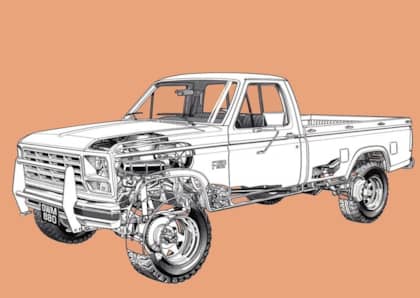The 700R4 and 4L60E Automatic Transmissions Shifted Hot Rod And Drag Car Builds For Decades
Although manual gearboxes get all the glory on the high performance scene, the reality is that automatic transmissions are far more common—and in some applications, much quicker in a straight line than a clutch-equipped vehicle.

Whether you're building a comfortable restomod cruiser or a lightning-fast drag car, chances are you've at least considered an automatic gearbox. If you're upgrading, modifying, or swapping in a GM-sourced V8 engine, there's an even stronger possibility that you've looked at either the 700R4 or the 4L60E, two of the most common, and popular, automatic transmissions of the past 40 years.

Together, the 700R4 and its 4L60E update have shifted generations of modern Chevrolet, Pontiac, Oldsmobile, Buick, and GMC eight-cylinder engines, and their history ties back to the very first Turbo-Hydramatic transmissions built by General Motors.
Deep Roots
By the end of the 1970s General Motors was looking for ways to reduce fuel consumption across its entire range of vehicles. One of the easiest ways to do this was invest in a new generation of overdrive-equipped automatic transmissions that could keep the revs down at highway speeds.

In 1982 GM introduced the TH700R4. Although the 'TH' stood for 'Turbo Hydra-Matic, the gearbox quickly became known simply as the 700R4, thanks in large part to being included across a surprisingly wide spectrum of rear-wheel drive and 4x4 vehicles.

Originally featuring a 27-spline output shaft, by 1985 the gearbox came to include a 30-spline output. All 700R4 transmissions offered a lock-up torque converter and a 0.69:1 overdrive gear, with a 3.06:1 first, a 1.625:1 second, and a direct-drive third gear ratio. This spread helped give the transmission respectable off-the-line performance without drinking down too much gas at speeds above 55 mph, making it a major improvement in terms of drivability over the TH350 and the TH400 that had preceded it. Highway rpm in some vehicles dropped by as much as 30 percent thanks to the 700R4.

The transmission was largely a work in progress for GM, which continued to make changes and upgrades to the 700R4 throughout its lifespan. These included a revised oil pumps (moving to a 10 vane design), improved internal sealing, and stronger pump rings and pump seals. Much of this development came about after weak spots in the design were identified through its use in the third-generation F-Body Chevrolet Camaros and Pontiac Firebirds, as well as heavy-duty trucks. By 1987 the gearbox had reached its most reliable form, and the run of automatics produced between '87 and '93 are regarded as the most desirable of the lot. These can be identified by looking for the auxiliary valve body, which is located underneath the pan.
Electronic Controls Arrive
In 1990 the 700R4 lost its 'Turbo' tag permanently and was renamed the 4L60. The '4' referred to the number of forward gears, the 'L' indicated that it was intended for longitudinal drivetrains, and the '60' denoted it was appropriate to use with a gross vehicle weight rating of 6,000 lbs.

Despite the new name the transmission soldiered forward status quo until 1993 when a major update was made. Rather than continue to use a mechanical, hydraulic-based throttle valve shifting system, the 4L60 gained an 'E' in its title to reflect the fact that shifts were now controlled electronically.

How did this work? Mechanically, the two transmissions were nearly identical, save for the lack of a valve body, TV cable, and governor, which were replaced by a vehicle speed sensor and a set of solenoids and actuators that shifted the gearbox from one ratio to the next. The entire system was controlled by a computer (with processing duties shared between an on-board controller and the vehicle's ECU), which decided when it was time to shift the transmission.

The transmission was further updated later in the '90s, garnering a removable bell housing, a 13 vane oil pump, and a 300 mm torque converter. The 4L60E would be used until 2012, encompassing both the traditional small block Chevy era as well as the Gen III and Gen IV LS V8 engines. A variant of the gearbox, the 4L65E, was found in the Pontiac GTO as well as larger Chevrolet, GMC, and Cadillac trucks starting in 2001, specifically to deal with higher torque output.
Which One To Use Where?
How does the 700R4 vs 4L60E compare? The advantages of the electronic control system on the latter transmission are plentiful. Unlike the valve body system, which discouraged full-throttle application in 3rd and 4th gears, the computer provides fully granular control over shifting and torque converter lockup. This means upshifts and downshifts are easily tunable, skirting around many of the issues associated with trying to do the same on a 700R4 using the hydraulic system and TV cable.

The downside to the 4L60E comes when installing it in an older vehicle that predates computer controls. Without an ECU designed to manage the transmission, it's necessary to go to a stand-alone controller, which adds cost and complexity to a build. You will also require a throttle position sensor and a vehicle speed sensor to provide the inputs the transmission controller needs. In many cases, it's easier and less expensive to go with a 700R4 on an older vehicle to avoid having to deal with modern engine controls.

Some muscle car and hot rod fans might also be concerned about 4L60E transmission problems that are frequently discussed online. It's important to remember that problems are disproportionately represented in Internet forums and chat groups, because people rarely post when things are going well with their project, and that millions of these transmissions are out there on the road. Many 4L60 / 700R4 issues on high horsepower builds can be dealt with by installing beefed up aftermarket parts, or by rebuilding a tired unit using stock parts from versions of the transmission that had these issues dealt with at the factory level.











